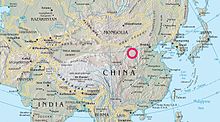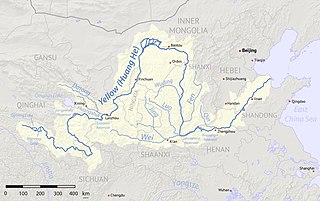The Mongols are an East-Central Asian ethnic group native to Mongolia and to China's Inner Mongolia Autonomous Region. They also live as minorities in other regions of China, as well as in Russia. Mongolian people belonging to the Buryat and Kalmyk subgroups live predominantly in the Russian federal subjects of Buryatia and Kalmykia.
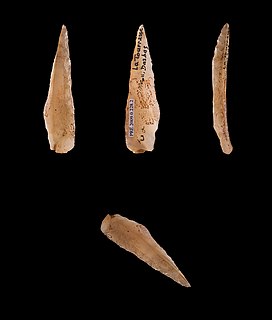
In archaeology, the Epipalaeolithic or Epipaleolithic is a term for a period intervening between the Upper Paleolithic and Neolithic in the Stone Age. This position is also occupied by the Mesolithic and the two are sometimes confused, or used as synonyms. More often they are used for different areas: Epipaleolithic for the Levant, and the Near East in general, as well as sometimes parts of Europe other than North and Western Europe, where Mesolithic is much more often used. A Mesolithic period is not usually recognized for the Levant or Near East; in Europe a period categorized as Epipalaeolithic is followed by a Mesolithic one in the same area, and will itself be described as Mesolithic by many archaeologists.

Inner Mongolia or Nei Mongol, officially the Inner Mongolia Autonomous Region or Nei Mongol Autonomous Region (NMAR), is one of the autonomous regions of the People's Republic of China, located in the north of the country. Its border includes most of the length of China's border with Mongolia. The rest of the Sino–Mongolian border coincides with part of the international border of the Xinjiang autonomous region and the entirety of the international border of Gansu province and a small section of China's border with Russia. Its capital is Hohhot; other major cities include Baotou, Chifeng, and Ordos.

The Xiongnu were a tribal confederation of nomadic peoples who, according to ancient Chinese sources, inhabited the eastern Eurasian Steppe from the 3rd century BC to the late 1st century AD. Chinese sources report that Modu Chanyu, the supreme leader after 209 BC, founded the Xiongnu Empire.
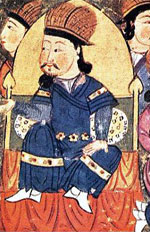
Altan Khan of the Tümed, whose given name was Anda, was the leader of the Tümed Mongols, Shunyi Wang of Ming dynasty China, and de facto ruler of the Right Wing, or western tribes, of the Mongols. He was the grandson of Dayan Khan (1464–1543), a descendant of Kublai Khan (1215–1294), who had managed to unite a tribal league between the Khalkha Mongols in the north and the Chahars (Tsakhars) to the south. His name means "Golden Khan" in the Mongolian language.

The Creswellian is a British Upper Palaeolithic culture named after the type site of Creswell Crags in Derbyshire by Dorothy Garrod in 1926. It is also known as the British Late Magdalenian. The Creswellian is dated between 13,000–11,800 BP and was followed by the most recent ice age, the Younger Dryas, when Britain was at times unoccupied by humans.
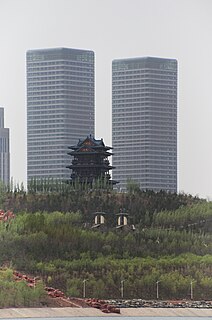
Ordos is one of the twelve major subdivisions of Inner Mongolia, China. It lies within the Ordos Plateau of the Yellow River. Although mainly rural, Ordos is administered as a prefecture-level city.

The Zhukaigou culture was a late Neolithic and early Bronze Age culture centered in the Ordos Plateau of Inner Mongolia, China. The type site at Zhukaigou was discovered in Ejin Horo Banner, Inner Mongolia, and excavated from 1977 to 1984. Zhukaigou culture is a reputed progenitor of the Ordos bronze culture and accordingly a first "Northern Zone" culture, extending to northern and central Inner Mongolia, northern Shaanxi, and northern Shanxi, with the Ordos region at its center. Transition to metalworking is dated to around the end of the third millennium BCE, at the same time was attained a higher level in the ceramic. Zhukaigou culture lasted to c. 1500 BCE.

The Ordos culture was a culture occupying a region centered on the Ordos Loop during the Bronze and early Iron Age from the 6th to 2nd centuries BCE. The Ordos culture is known for significant finds of Scythian art and is thought to represent the easternmost extension of Indo-European Eurasian nomads, such as the Saka. Under the Qin and Han dynasties, from the 6th to 2nd centuries BCE, the area came under at least nominal control of contemporaneous Chinese states.

Émile Licent was a French Jesuit trained as a natural historian. He spent more than twenty-five years researching in Tianjin. His expeditions spread across various parts of Northern and Central China.

The prehistory of Southeastern Europe, defined roughly as the territory of the wider Balkan peninsula covers the period from the Upper Paleolithic, beginning with the presence of Homo sapiens in the area some 44,000 years ago, until the appearance of the first written records in Classical Antiquity, in Greece as early as the 8th century BC.
The Upper Mongols, also known as the Köke Nuur Mongols or Qinghai Mongols are ethnic Mongol people of Oirat and Khalkha origin who settled around Qinghai Lake in so-called Upper Mongolia. As part of the Khoshut Khanate of Tsaidam and the Koke Nuur they played a major role in Sino–Mongol–Tibetan politics during the 17th and 18th centuries. The Upper Mongols adopted Tibetan dress and jewelry despite still living in the traditional Mongolian ger and writing in the script.

The Ordos are a Mongol subgroup that live in Uushin district, Inner Mongolia of China. Ordos literally means plural of Ordo.
John W. Olsen, Ph.D., is an American archaeologist and paleoanthropologist specializing in the early Stone Age prehistory and Pleistocene paleoecology of eastern Eurasia. Olsen is Regents' Professor Emeritus of Anthropology and Executive Director of the Je Tsongkhapa Endowment for Central and Inner Asian Archaeology at the University of Arizona in Tucson, Arizona, USA. He is also a Leading Scientific Researcher at the Institute of Archaeology and Ethnography of the Russian Academy of Sciences' Siberian Branch in Novosibirsk and Guest Research Fellow at the Chinese Academy of Sciences' Institute of Vertebrate Paleontology and Paleoanthropology in Beijing where he is Co-Director of the Zhoukoudian International Paleoanthropological Research Center (周口店国际古人类研究中心联席主任). Olsen is also a Foreign Expert affiliated with The Yak Museum in Lhasa, Tibet (西藏牦牛博物馆国外专家).

Altanochir (1882–1949) was an Inner Mongolian prince, politician, and general under the Republic of China and Mengjiang governments. He served as deputy head of Yeke-juu League. An ethnic Mongol, he was a native of Right-Wing Rear Banner, Ordos.

Mongolian shamanism, more broadly called the Mongolian folk religion, or occasionally Tengerism, refers to the animistic and shamanic ethnic religion that has been practiced in Mongolia and its surrounding areas at least since the age of recorded history. The Mongolian endonym is Böö mörgöl. In the earliest known stages it was intricately tied to all other aspects of social life and to the tribal organization of Mongolian society. Along the way, it has become influenced by and mingled with Buddhism. During the socialist years of the twentieth century it was heavily repressed and has since made a comeback.
Manhan folk songs are very popular in Zhunger Banner (Ordos). Dalate Banner(Ordos)(Banner is a Mongolian administrative unit which equals a county), and Tumote Banners(covering the borderland of Huhhot. and Baotou3) of Inner Mongolia Autonomous Region in China. Melody and lyrics are its two principal features. In melody, it primarily bases on boginoduu(short-tune Mongolian song of Erdos), taking merits of Mountain-climbing Song at the same time; in lyrics, it largely relies on Mandarin Chinese, emphasizing the combination of Chinese and Mongolian language as well. Several masterpieces are “Wang’ai Lama Temple”, “Planting a Willow”, “Chairman Mao brings us Happiness”.

Religion in Inner Mongolia is characterised by the diverse traditions of Mongolian-Tibetan Buddhism, Chinese Buddhism, the Chinese traditional religion including the traditional Chinese ancestral religion, Taoism, Confucianism and folk religious sects, and the Mongolian native religion. The region is inhabited by a majority of Han Chinese and a substantial minority of Southern Mongols, so that some religions follow ethnic lines.
